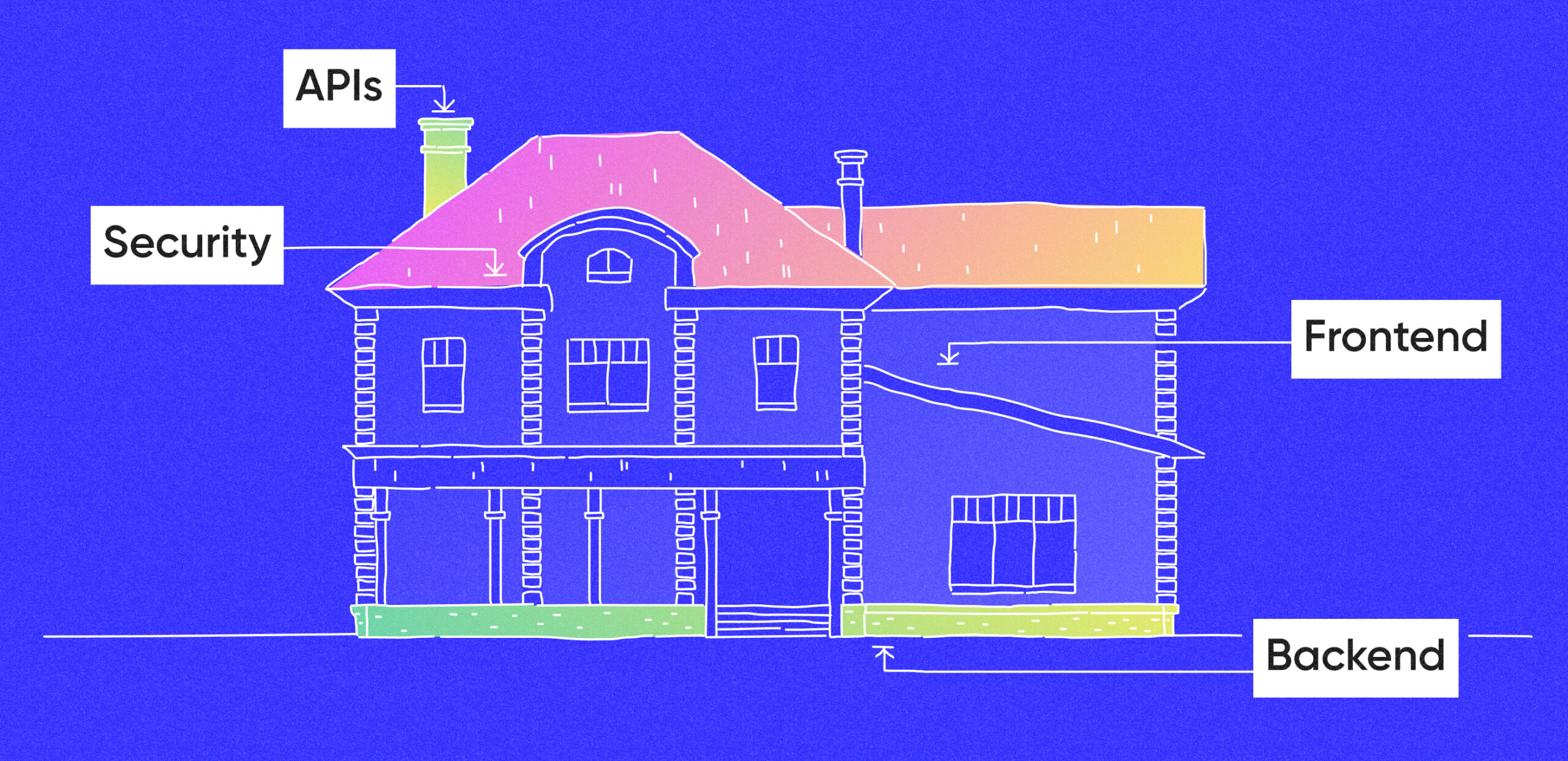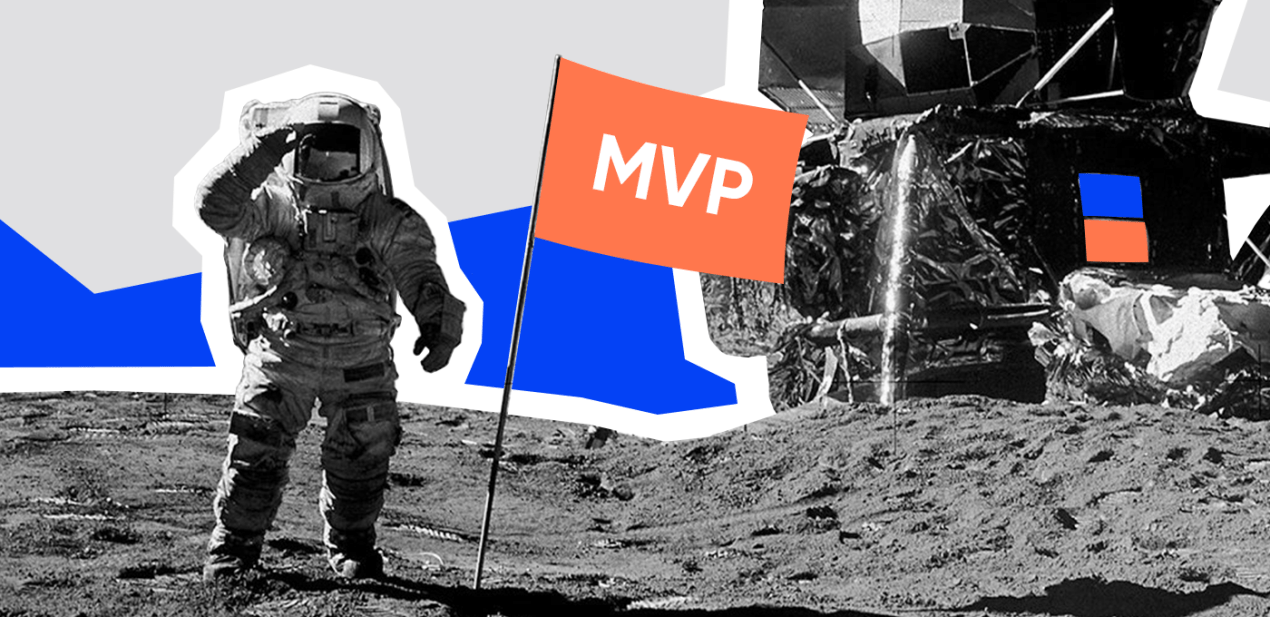Key Takeaways
-
- A tech stack refers to a set of technologies, frontend and backend components, frameworks, databases, and programming languages that many developers use to create apps.
- The article discusses the three most popular tech stacks: JS, Flutter, and PHP. For each of them, we’ve gathered the components used for frontend and backend development, as well as compatible databases.
- The benefits of selecting the right tech stack are increased efficiency, rapid development, cost-effectiveness, and simple workflows.
- Choosing the wrong tech stack may lead to slower development, maintenance challenges, scalability issues, and difficulty finding skilled developers.
What is a tech stack?
Let’s start with the technology stack definition.
A tech stack refers to a combination of technologies used to build software applications. It includes programming languages, frameworks, databases, and other tools.
A tech stack for startups works as a foundation upon which they build their digital presence. It includes both the frontend and backend components, along with other essential technology infrastructure.
To explain how it works, we can use an analogy. Tech stack means a set of tools used to build an app, and it could be compared to the components used to build a house.
| 🏠 House | 📱 Application | |
| Foundation (Backend) | The foundation provides stability and supports the entire structure. | The backend serves as a foundation. It includes server-side technologies and databases that handle data storage and processing. |
| Walls and Facade (Frontend) | The walls and facades are what people see and interact with. They provide aesthetics and functionality. | The frontend of an app and a user interface is what users interact with. It includes HTML, CSS, and JavaScript. |
| Plumbing and wiring (APIs) | Piping and wiring the house is necessary to connect it to the city infrastructure and to supply it with water and electricity. | APIs and data processing mechanisms are the plumbing and wiring for the app, as they help get and use data from external sources. |
| Utilities (Third-party services) |
To make a house comfortable, people use utilities like electronics, smart home appliances, and the internet. | To make an app more useful, developers integrate payment gateways, authentication services, and cloud infrastructure. |
| Roof cameras (Security measures) |
To keep the house safe, it has a reinforced roof and can be surrounded by a fence. | Encryption and authentication serve as the digital “roof” and help protect the app. |
In both instances, the various components work together to create a robust structure.
Does the tech stack influence a startup’s success?
How you plan your development process and which tech stack you choose will determine the future growth of your business. There’s no need to hurry, . I it’s better to weigh the pros and cons.
The right tech stack can:
-
- help a startup launch an IT-product faster;
- help a startup scale more efficiently;
- reduce the cost of application development;
- ensure faster time-to-market;
- simplify workflows for the development team.
The choice of a tech stack for startups can affect the quality of the product, user experience, and ease of maintenance.
The wrong tech stack can:
-
- lead to poor overall performance, such as slow response times;
- cause scalability issues;
- extend development timelines and increase costs;
- lead to security vulnerabilities and expose the app to cyber threats;
- make it challenging to maintain and update the app.
To mitigate these risks, when selecting a technology stack, you need to assess your project requirements and consider factors such as scalability and maintainability.
Let’s look at an example: Alex runs a small business. He wants to create a mobile application for his employees so that they can log the time they come to work, start and end their breaks, and leave the office. This makes it easy for employees to track the hours they work monthly, and overtime or missed hours will be accounted for to ensure transparency in the payments.
These kinds of apps are usually pretty simple, single-page applications. When choosing a startup tech stack, Alex did not plan to implement military-grade data encryption, payment gateways, connections to social networks, or advanced animations. There is no reason for him to overpay for these complex features. All he needs is a database, an intuitive interface, and autosave functionality. If the tech stack is selected wisely, his idea can be implemented cheaper and faster, with maximum benefit for the business.
What factors should you consider when choosing a startup tech stack?
To ensure an effective combination of tools and frameworks, several factors need to be carefully analyzed. Each of them will contribute to the balance between innovation, productivity, and long-term sustainability.
Type of project
Before you start coding, you should carefully study the project requirements. Determine whether you want a web, mobile, cross-platform, or desktop app. Decide what tasks it will perform. The scope and complexity of the project are also important. One programming language may be ideal for developing enterprise web solutions or ERP (Enterprise Resource Planning) systems, but not suitable for single-page applications. You can find out which technologies are most commonly used for projects similar to yours.
Cost
The next cornerstone is the budget you set aside for app development. This includes not only license fees for certain technologies, but also long-term maintenance costs, upgrades, and potential scaling costs. Open-source technologies are typically cost-effective, while complex features and innovative approaches are more likely to cost more.
If the chosen tech stack for startups is unfamiliar to the development team, they may need time to learn it, and this will lead to an increase in costs. Sometimes it’s useful to look at more popular solutions, as you will find experts who already know this stack and have a lot more experience with it. Try to assess the total cost of development from the start, so you don’t end up with a half-baked product by the time the money runs dry. We’ve put together tips for estimating costs and timelines in the article below:
Scalability
Scalability is crucial to accommodate growth and ensure that the system can handle increased loads, as the user base expands. Consider the scalability of both the backend and frontend components to avoid performance bottlenecks.
Consult the experts to learn more about the ways you can scale your app. You may want to ask the following questions:
-
- Can the selected database scale with growing data volumes?
- Is the server framework able to handle the increased traffic?
- Is there an option for horizontal scaling?
Development speed
When you come up with an idea to create a new product, you may want to hit the market as fast as possible. Of course, developers can’t create the perfect app in a couple of days, and you need to set aside time for development.
But if time-to-market is very important, you can try to reduce the development time with the help of the correct choice of frameworks. Check whether the framework provides fast development, whether it has libraries or tools for code reuse, and how easy it is for developers to customize the development environment.
Ease of learning
This point is especially important for those who want to create a complex app. For example, it can be a marketplace which needs product cards, filters, a search bar, a rating system, payment gateways, a chatbot with technical support, and more. To create a system like this, you require a whole set of frameworks and tools. If you want to implement something even more advanced, like VR or crypto payments, the complexity of the stack will increase.
You’ll need to either ensure that your team learns the technology and is capable of applying it, or you need to call in the experts. The easier the stack is, the faster you can create a product, and vice versa.
Ease of maintenance
Maintenance is an ongoing aspect of software development. A technology stack that is easy to maintain reduces the likelihood of bugs, provides smoother updates, and makes it easier to add new features over time. Here it’s also important to consider the cost of maintenance, if you use any technologies on a subscription or per-purchase basis.
Think about the type of databases you will be using and the availability of automated testing tools. Learn how often security updates and patches are released for the selected technologies. Only if you are completely satisfied with it, can you safely start using this stack. If not, look at possible analogs and compare their pros and cons.
Top 3 tech stacks for startups in 2024
The best tech stack is the one that aligns with your needs. Still, there are several widely used options that have their benefits and drawbacks. In this section, we’ll discuss the JS, Flutter, and PHP tech stacks. This part is all about the technical details, but don’t fret. Even if you’re far from programming and specialize primarily in business tasks, a general understanding of this technology can be useful.
JavaScript stacks
Any JavaScript stack includes a database, a backend framework, and a frontend framework or a library. There are other components, like a package manager, a version control system (Git), module bundlers, compilers, and cloud platforms. These components are used together to develop applications.
Frontend. JavaScript frameworks like React Native, React,js, Angular.js, or Vue.js are used for client-side development.
-
- React.js is a popular JavaScript library for building user interfaces, that allows developers to create reusable UI components.
- Angular.js is a full-fledged front-end framework for creating dynamic web apps. It follows the Model-View-Controller architecture.
- Vue.js is a progressive JavaScript framework for building UIs. It’s incrementally adaptable and can be integrated with other libraries and projects.
Backend. Node.js and Django are the most popular choices for server-side scripting.
-
- Node.js is a JavaScript runtime that allows developers to run JavaScript on the server side.
- Django is a high-level Python web framework. When combined with Node.js for handling asynchronous tasks, it can form a full-stack solution.
Database. The most typical databases that underlie applications written using the JS stack, include MongoDB and MySQL.
-
- MongoDB is a NoSQL database that stores data in a flexible, JSON-like format. It’s often used with Node.js and Express.js.
- Depending on the project requirements, a traditional relational database like MySQL or PostgreSQL might be used instead of a NoSQL database.
All these elements can make up three completely different tech stacks:
Each of these stacks provides a full development environment for building scalable and efficient web apps, each of them having their own strengths and use cases. The choice between them often depends on the development team’s expertise, the specific requirements of the project, and personal preferences. These stacks enable mobile and web development using a single language popular among developers, such as JavaScript.
Benefits of using the JavaScript stack:
-
- Developers can write both frontend and backend code using the same language, making it easier to switch between tasks and maintain consistency.
- JavaScript is a versatile programming language with a multitude of possible apps. It is a go-to choice for various web development needs.
- JavaScript has a vast ecosystem of libraries, frameworks, and tools, as well as an active community that keeps improving them.
Flutter stack
Flutter is an open-source user interface software development kit created by Google. It’s used for creating native-like apps for mobile devices, websites, and desktops using a single code base. Tech startups choose Flutter because of its cross-platform development capabilities, high performance, and an expressive and customizable user interface. Find out if it’s suitable for your business in this article.
The Flutter stack typically involves the following components: the core software development kit, Dart programming language, state management solutions, widget libraries, a version control system (Git), and testing frameworks.
Frontend. Flutter provides a set of Material Design and Cupertino widgets, layouts, and themes to build modern and visually appealing user interfaces. Many developers use additional third-party libraries for specialized widgets or UI components.
-
- Material Design widgets are pre-designed widgets that comply with the Material Design guidelines, ensuring a consistent UI.
- Cupertino are iOS-style widgets used for achieving a native look and feel on iOS devices.
Backend. Flutter can be integrated with various backend services, such as Firebase, AWS Amplify, or Parse, to handle server-side logic, authentication, and data storage.
-
- Firebase is well-suited for apps with real-time data synchronization needs. It offers fast development of apps that require authentication and cloud infrastructure.
- AWS Amplify is used for apps that require a scalable and modular backend architecture. It provides a higher level of customization, but may have a steeper learning curve.
- Parse is used by developers who prefer open-source solutions; it allows launching apps with real-time features but requires more setup and management.
Database. Flutter supports various databases, such as SQLite and Realm, to store and manage application data.
-
- SQLite is a lightweight, self-contained database engine that allows you to store and retrieve data locally on the device.
- Realm is a mobile database that is designed to be fast, efficient, and easy to use. It can also be used as a local database.
Benefits of using the Flutter stack:
-
- Flutter allows developers to apply object-oriented programming to any element, which speeds up the development process.
- Developers can create a single codebase and use it across multiple platforms (Android, iOS, desktop, and the web). This can significantly reduce expenses.
PHP stacks
A PHP stack refers to a combination of technologies used for building web applications using the PHP programming language. Similar to other stacks, the PHP stack includes a frontend framework, a backend framework, a database, and a server-side language. It also offers object-relational mapping, a package manager, and a version control system (Git). Web application servers, containerization, and firewalls are optional.
Frontend. PHP, being a server-side language, is mainly used to generate dynamic content on the server. The fundamental technologies for building a user interface and processing interactions on the client side are HTML, CSS, and JavaScript.
Backend. Hypertext Preprocessor (PHP) scripting language processes requests, interacts with the database, and generates dynamic content. PHP is embedded in HTML code, making it easy to mix server-side logic with frontend markup.
Database. Relational database management systems (RDBMS) commonly used with PHP for storing and retrieving data are MySQL, MariaDB, and PostgreSQL.
-
- MySQL is suitable for a wide range of apps, from small-scale websites to large-scale enterprise systems. It’s used with content management systems like WordPress, Drupal, and Joomla.
- MariaDB is used to replace MySQL, especially in projects where the community-driven and open-source nature of the database is a priority. It focuses on security and performance improvements.
- PostgreSQL is known for its extensibility, standards compliance, and advanced features. It’s well-suited for apps that require complex queries, transactions, and data integrity, for example, in GIS (Geographic Information System) apps.
Web server. A widely used open-source web server is Apache. Alternatively, developers use the Nginx web server. The servers handle incoming HTTP requests, execute PHP scripts, and send the generated content back to the client.
-
- Apache is highly modular, allowing users to extend its functionality. It is used in web hosting environments such as shared hosting, virtual private servers (VPS), and dedicated servers.
- Nginx (Engine-X) is a high-performance web server that has gained popularity for its efficiency and scalability. It uses an event-driven, asynchronous architecture and is commonly used as a reverse proxy, forwarding requests to other servers.
If you combine web servers and databases in different ways, you will get three PHP tech stacks:
Each stack is adapted to different operating systems (Linux or Windows) and includes the basic components for building web applications written in PHP. The choice between these stacks depends on factors such as the development environment, familiarity with technology, and project requirements.
Benefits of using the PHP stack:
-
- PHP has multiple frameworks and libraries that can be used to build web apps, as well as a large and active community that contributes to the improvement of libraries.
- It is entirely open source, allowing users to use frameworks, run code, and access resources without any cost.
- PHP is compatible with various operating systems, web servers, and databases. It also offers fast performance, and is easy to maintain.
Why popular tech stacks may not be the best option for your startup
While popular tech stacks can be a good starting point, the best tech stack for startups depends on your specific needs and goals. A stack that suits one startup may not be the best fit for another. So don’t chase after what’s popular, the best tech stack is the one that aligns with the startup’s vision, team expertise, and long-term goals.
In order to make the best possible choice, you need to consider the following aspects:
-
- Popular tech stacks often come with a level of complexity that may be unnecessary for the initial needs of a startup. Also, complex frameworks can introduce additional overhead costs.
- Startups often work with small teams, and the time it takes for a team to learn a complex technology stack can hinder rapid development.
- Some popular technologies may have associated costs, such as license fees, premium support, or cloud infrastructure costs.
- Popular stacks cater to a broad range of use cases, including complex enterprise-level apps. For startups building MVPs, using a stack such as this may simply be redundant.
- Startups require the flexibility to quickly re-adjust based on market feedback. A popular stack can limit the ability to make changes quickly or experiment with alternative technologies.
- Tech startups may find that newer, more niche technologies better align with their vision and requirements.
And if you don’t have the time or level of expertise to consider all of these things, there’s an easier way — outsourcing the project to a team of professionals.
Benefits of choosing the right startup tech stack
Choosing the right startup tech stack leads to faster development and lower costs. It can also help a startup scale more efficiently and adapt to changing market conditions. Let’s look at examples of how a stack for startups can benefit you.
Efficiency and performance
Using the right tech stack, developers can optimize performance and make sure that everything runs smoothly and meets user expectations. A scalable and well-supported database such as MongoDB, MySQL, or MariaDB, can prevent performance bottlenecks as your user base grows.
Rapid development
To help a startup launch an IT-product faster, consider using the tech stack that facilitates faster development cycles. It could be Flutter, as it offers cross-platform development and allows for code reuse. Other frameworks and tools that support agile development can also accelerate the software development process. This allows your team to iterate quickly and release new features or updates on time.
Cost-effectiveness
Choosing the right tech stack helps to manage costs, both in terms of initial development expenses and ongoing maintenance. Open-source technologies, such as PHP stack (as well as cloud services), are cost-efficient alternatives to proprietary software. However, if you see fit to use licensed private tools, you may do so.
Simple workflows for the development team
Developers can focus more on writing code and building features rather than grappling with complex configurations or unfamiliar technologies. New team members quickly become productive, reducing the time and resources required for training. If the tech stack is right, the team can quickly identify and address issues or fix bugs, as well as smoothly deploy updates.
Drawbacks of choosing the wrong tech stack for startups
A poorly chosen tech stack can lead to delays, inefficiencies, and higher costs. Here are some common pitfalls to avoid and their examples.
Increased development time
The wrong stack may lead to longer development cycles and delays in bringing the product to market. For example, component or tool incompatibility issues can slow down development.
Maintenance issues
A tech stack lacking proper support and documentation can result in maintenance challenges. If you rely on outdated or deprecated technologies, it may lead to security vulnerabilities and additional maintenance efforts.
Limited scalability
Choosing a non-scalable tech stack may hinder the ability to handle increased user loads, limiting the startup’s growth potential. For instance, using a database that doesn’t scale well could result in performance issues as the user base expands.
Difficulty in finding skilled developers
Uncommon or niche technologies may make it challenging to find skilled developers, which potentially leads to a shortage of talent. But there are two sides to this coin. On the one hand, an obscure programming language may limit the pool of available developers. On the other hand, if you need those specific niche technologies, put in the time in advance to find the labor, and everything will go as planned.
Summary
The right technology stack significantly influences development speed, scalability, and cost. Consider your project type, projected costs, desired scalability, and development speed. Remember that launching the app is not the final step. You will have to constantly update it, remove possible bugs, and add new features. If the startup tech stack is chosen correctly, this will be easy to do.
At Purrweb, we have been developing IT-products for more than 9 years, and we emphasize the need for alignment with business goals in selecting the stack. Choosing the best technology stack depends on the specific goals of the startup, not just what’s popular right now. We discussed three popular stacks for tech startups — JavaScript, Flutter, and PHP. You can choose one of them or find an alternative that suits you better.
We are glad to answer all your questions regarding web, desktop, and mobile application development. Fill in the form below, and we will contact you in 48 hours. Launch your app with Purrweb!



















